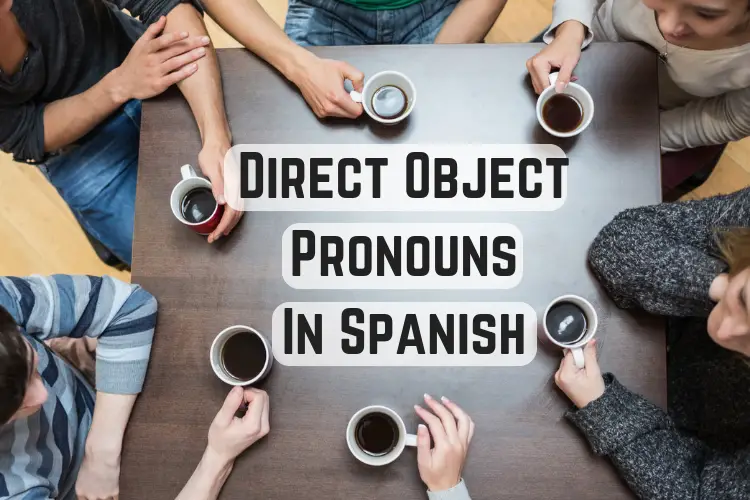Contrary to what you may think, direct object pronouns in Spanish are here to make your life easier.
Spanish direct object pronouns like me, te, lo, and la are an essential part to a Spanish speakers vocabulary so it’s important that you fully grasp this concept.

In this concise article, I’m going to walk you through all the crucial elements of these pronouns that you need to know.
I will be providing you with a plethora of examples to make sure you are fully grasping this topic.
Now let’s get down to business!
What Are Spanish Direct Object Pronouns?

Alright, I know what you might be thinking, what exactly is a direct object pronoun in Spanish?
Simply put, a direct object pronoun replaces a direct object, which is a noun.
By doing this, you avoid unnecessarily repeating the noun.
The noun in question could be a person, a thing, or a noun phrase that directly receives the action of the verb in a sentence.
Did I already lose you?!
If so, no worries, there will be lots of examples coming your way to make sense of all this pronoun jargon.
When you replace the direct object with a direct object pronoun you must make sure it agrees in number (singular, plural) and gender (feminine, masculine).
Singular | Plural |
me (me) | nos (us) |
te (you, familiar) | os (you-all-familiar) |
lo, la (him, her, it, you-formal) | los, las (them, you-all-formal) |
It’s not just a Spanish thing though. You have direct object pronouns in English too.
The main difference between the use of direct object pronouns in Spanish and in English is their placement. While in English they are placed after the verb, in Spanish this pronoun is placed in front of the verb.
Let’s take a look at some helpful examples. Remember the direct object (noun) can be a person, a thing, or a noun phrase.

Juan cocinó la torta. =>
Juan baked the cake.
Juan la cocinó. => Juan baked
it.
“Torta” receives the action of the verb “cocinar.”
Pepe besó a Lisa. =>
Pepe kissed Lisa.
Pepe la besó. => Pepe kissed
her.
“Lisa” receives the action of the verb “besar.”
Clara comió las manzanas. => Clara ate the apples.
Clara las comió. => Clara ate
them.
“Manzanas” receives the action of the verb “comer.”

Spanish pronouns work the same way. We use them to avoid repetition.
Marcos sonríe porque Marcos es feliz. => Marcos smiles because Marcos is happy.
Marcos sonríe porque él es feliz. => Marcos smiles because he is happy.
Direct Object Pronouns in Spanish: Key Details
Let's take a closer look at how direct object pronouns work.
Don’t worry it gets easier...
Direct Object Pronouns And People: Whom?
Like we established at the beginning of the article, a direct object pronoun replaces a direct object, which is a noun that, among other things, can be a person.
Here’s a question for you.
Whom is the action of the subject (that which gives the action) affecting?
Your answer is the direct object noun.
Remember to make sure the direct object pronoun agrees with the noun in number (singular, plural) and gender (feminine, masculine).
Let’s break it down.

“Sus amigos” is the direct object (noun), which can be replaced by the direct object pronoun “los.”
Los niños los abrazaron. => The kids hugged them.
Here are a few more examples.
La policía detuvo a los ladrones. => The police detained the thieves.
La policía los detuvo. => The police detained them.
La lluvia mojó a Ana. => The rain got Ana wet.
La lluvia la mojó. => The rain got her wet.

La película entristeció al señor Parker. => The movie saddened Mr. Parker.
La película lo entristeció. => The movie saddened him.
La película nos entristeció (a nosotros). => The movie saddened us.
La película me entristeció (a mí). => The movie saddened me.
La película te entristeció (a tí). => The movie saddened you.
La película os entristeció (a vosotros). => The movie saddened you.
Direct Object Pronouns And Things: What?
First, we identify the thing (noun) that receives the action of the verb and then we proceed to replace it with the correct direct object pronoun (masculine, feminine, singular, plural).
What is the action of the subject of the sentence affecting?
El huracán destruyó la casa. => The hurricane destroyed the house.
Check it out, “la casa” is receiving the action of “destruir.
So that translates to...
El huracán la destruyó. => The hurricane destroyed it.
Here are a few more examples.
Pedro cortó el árbol. => Pedro cut the tree.
Pedro lo cortó. => Pedro cut it.

Carlos me rompió el corazón. => Carlos broke my heart.
Carlos me lo rompió. => Carlos broke it.
La fe me devolvió la esperanza. => Faith restored my hope.
La fe me la devolvió. => Faith restored it.
Direct Object Pronouns And Noun Phrases
The only difference to the previous examples (people and things) is that noun phrases use more words.
José compró muchas flores. => José bought a lot of flowers.
José las compró. => José bought them.
Clara ha escrito una innumerable cantidad de poemas. => Clara has written an endless amount of poems.
Clara los ha escrito. => Clara has written them.
Spanish Direct Object Pronouns In Negative Sentences And Questions
Take a look at the placement of the direct object pronoun in negative sentences with only one verb.
Let’s compare an affirmative and a negative sentence so you can see it clearly.
First, let's start with an affirmative sentence.

Él lee novelas románticas. => He reads romantic novels.
Él las lee. => He reads them.
Negative sentence
Él no lee novelas románticas. => He doesn’t read romantic novels.
Él no las lee. => He doesn’t read them.
Let’s compare a few more.

Ella las quiere. => She wants them.
Ella no las quiere. => She doesn’t want them.
Ellos lo buscan. => They look for him/it.
Ellos no lo buscan. => They don’t look for him/it.
Los entregué. => I delivered them.
No los entregué. => I didn’t deliver them.
Ellos nos gritaron. => They yelled at us.
Ellos no nos gritaron. => They didn’t yell at us.
As you can see, the placement of the word “no” after the subject, makes the whole sentence negative.
Now let’s compare affirmative and negative sentences with two verbs.
When this happens, the first verb is conjugated and the second one remains in the infinitive form.
Also, there are two possible spots for the direct object pronoun: right before the conjugated verb or attached right after the infinitive.
?
Spanish Direct Object Pronoun Comparison
Option 1
Lo quiero estacionar. => I want to park it.
No lo quiero estacionar. => I don’t want to park it.
Option 1
La puedo terminar. => I can finish it.
No la puedo terminar. => I can’t finish it.
Option 1
Lo prefieren escuchar más tarde. => They prefer to listen to him/it later.
No lo prefieren escuchar más tarde. => They don’t prefer to listen to him/it later.
Option 2
Quiero estacionarlo. => I want to park it.
No quiero estacionarlo. => I don’t want to park it.
Option 2
Puedo terminarla. => I can finish it.
No puedo terminarla. => I can’t finish it.
Option 2
Prefieren escucharlo más tarde. => They prefer to listen to him/it later.
No prefieren escucharlo más tarde. => They don’t prefer to listen to him/it later.
I have good news for you! These same rules apply for questions, both affirmative or negative!
Ella las quiere. => She wants them.
¿Ella las quiere? => Does she want them?
Los entregué. => I delivered them.
¿Los entregué? => Did I deliver them?
La puedo terminar. => I can finish it.
¿La puedo terminar? => Can I finish it?
Puedo terminarla. => I can finish it.
¿Puedo terminarla? => Can I finish it?
Summing Up the Essentials...

As a reminder, what is a direct object pronoun in Spanish?
- Direct object pronouns are: me, te, lo, la, nos, os, los, las.
- Noun and direct object pronouns must agree in number (plural, singular) and gender (feminine, masculine).
In order to master these pronouns those are two rules you must know.
In addition, direct object pronouns replace…
- People - Marcos ama a Claudia. Marcos la ama. => Marcos loves Claudia. Marcos loves her.
- Things - Marcos compró el auto. Marcos lo compró. => Marcos bought the car. Marcos bought it.
- Noun phrases - Marcos lee muchas novelas románticas. Marcos las lee. => Marcos reads a lot of romantic novels. Marcos reads them.
Affirmative vs. Negative sentences => Same Rules Apply to Questions!
Here’s a few examples of affirmative and negative sentences.
Notice how option 1 and 2 have two verbs and can be used in two different ways.

Marcos no la ama. => Marcos doesn’t love her.
When there are two verbs you have two options...
Option 1
Marcos la quiere amar. => Marcos wants to love her.
Marcos no la quiere amar. => Marcos doesn’t want to love her.
Option 2
Marcos quiere amarla. => Marcos wants to love her.
Marcos no quiere amarla. => Marcos doesn’t want to love her.
Final Piece of Advise (For Spanish Students)
There is one more important thing to remember.
Even though the two languages share similarities, Spanish and English ARE completely different languages.
You’ve probably noticed that sometimes you are able to translate word for word...
Pedro come bananas. => Pedro eats bananas.
Pedro las come. => Pedro eats them.
...and sometimes it’s just not that easy.

La compré.
=> I bought it.
Lo compré.
Confusing, right?
Sometimes a literal translation can end in a hot mess.
La compré (DOES NOT EQUAL) It I bought. Do NOT attempt to do this at home!
When it comes to translating, you must be open minded.
Over time, you will learn to translate groups of words and phrases, without questioning it and without translating word for word. Accept and embrace.
Lo acepto. I accept it.
Once you do this, you will be a happier Spanish student because of it. I’m completely confident you will be speaking with Spanish direct object pronouns in no time.
Te lo prometo.


Great explaination of direct object pronoun use. Thank you. I do have a question. In the following examples why is the word ‘me’ left in the sentence using the d.o. pronoun?
Carlos me rompió el corazón. => Carlos broke my heart.
Carlos me lo rompió. => Carlos broke it.
La fe me devolvió la esperanza. => Faith restored my hope.
La fe me la devolvió. => Faith restored it.
I don’t see the answer to your very good question. My guess is that the verb is reflexive it I’m not sure if that is the answer. Please help. Thank you.
In the sentence, “Carlos me lo rompió”, inclusion of the “me” preserves the noun phrase, “MY heart”.
That’s a good question about the “me” being left. It seems like it is an indirect object.
If I said “Carlos wrote me a letter”, He wrote the letter, not me. “me” is the indirect object. That seems to be a more advanced topic.
He broke the heart, not me. It does seem possible to leave off the me and still have good sentence(?)
.
It can be a good sentence either way. The difference is intent. Was it on purpose or an accident? Yes, it is an elevated grammar concept for the Spanish language.
Because you are using a double pronoun. Direct Object pronoun and Indirect Object pronoun.
This was very helpful and easily understandable. Thanks for the clear explanation.
Glad you found it useful Karen. Thanks for reading. 🙂
Hola, ¿cómo estás? Vengo a comentar para decirte en serio felicitaciones por tu blog está súper completo y tiene todo muy bien explicado. Pienso que si alguien no sale de aquí aunque sea sin un poco de conocimiento, no sé en que está pensando. Sigue así, ayudarás a muchos.
Saludos desde Venezuela.
Hola Sabrina,
Muchas gracias por tu lindo comentario. Me alegra escuchar que te gusta lo que estamos haciendo, y sí, queremos ayudar a muchos. Un abrazo.
Andrea
In, “he wrote it to me” (me lo escribió), the “me” would be an indirect object (to me), but in the sentence, “me lo rompió”, the “me” modifies “it” and is an adjective that is included for clarity. Yes?/no? BTW, I used autofill above so you see my nom de plume, Daniel Dare. Sorry about that,
Hi, I´d like to offer an alternative explanation regarding “me lo rompió.” I am no Spanish expert! But me as an adjective modifying it, doesn´t really make sense to me. The form here doesn´t quite seem reflexive because the verb (romper) does not really refer back to the subject (Carlos). My guess, and it is a guess, is that this expression points to whose heart was broken, but is not really directly translatable into English. Thoughts?
Very helpful, felt like I really understood
Good to hear, Jacob!
I think that I will visit this site more often.
Glad you are finding it useful, Mrs. Brenda.
Can someone help me please… I cannot get my head around the lo/la /le bit.. for instance
Lo quiero estacionar
La puedo terminar
Why one is lo and the other la
I don’t know really how to explain … I just can’t get passed this part of the course
Exactly, like Chris explained.
If you’re wanting to park a car (el carro) it’s:
Lo quiero estacionar.
If you’re wanting to park a motorcycle (la motocicleta) then it’s:
La quiero estacionar.
More than one, Los quiero estacionar, Las quiero estacionar.
Same with the other example,
Lo puedo terminar. (for example, “el examen”)
La puedo terminar. (“la tarea”)
plural: Los puedo terminar. Las puedo terminar.
Haha, I used to dislike grammar as a child. =)
One is lo and one is la Likely due to the object or noun they’re replacing. Even though they don’t exactly say what or whom lo or la is replacing, we can try to deduce. Language instructors usually use previous examples for future ones. So For the first example Lo quiero estacionar, what do you want to park? It. What is it? Likely a car. Car= el carro/ el coche. Therefore you would use lo since it is for the masculine sense of the word. And the same probably goes for whatever they’re trying to finish in the second one. La puedo terminar. What did they want to finish? Earlier they mentioned a novel, la novela. they thought they could finish the novel. That’s why they used La. hope this helped
Thanks, Chris!
A modo de aclaratoria sobre el complemento directo, El Complemento Directo es la persona, animal o cosa sobre la que recae la acción del verbo. Suele seguir al verbo y no lleva preposición (la única preposición que puede acompaña a un complemento directo es “a”). No concuerda con el verbo. Un ejemplo: María cuida al bebé. María lo cuida. El bebé es el complemento directo, no indirecto, puesto que la acción recae sobre el bebé, aúnque responda a la pregunta ¿a quíen?
La fe me la devolvio =>Faith gave it back to me
Very nice explanation thank you
Thanks for following along!
Explicación perfecta y acompañado con excelentes ejemplos.
Si necesito más ayuda en otros topics los puedo buscar en Spanishlandschool.com.? y el Tema que necesito ayuda?
🙂